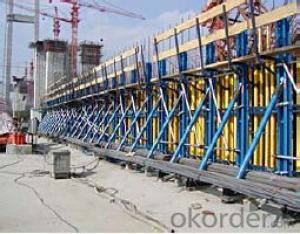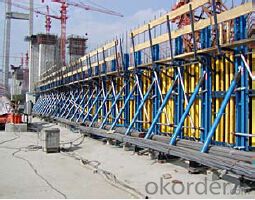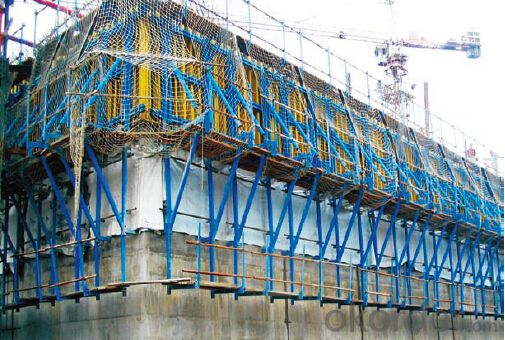Single-side climbing bracket for formwork and scaffolding systems
- Loading Port:
- Tianjin
- Payment Terms:
- TT OR LC
- Min Order Qty:
- 50 m²
- Supply Capability:
- 1000 m²/month
OKorder Service Pledge
OKorder Financial Service
You Might Also Like
Single-side Climbing Bracket SCB180:
With CNBM SCB 180 climbing systems, the loads from the fresh concrete pressure are
transferred through the brackets by means of V-strongbacks and compression braces into the
scaffold anchors.
Typical applications for the SCB 180 are dams, locks, cooling towers, pier heads, tunnels, and
bank vaults.
The formwork is simply tilted backwards when striking takes place. The 1.80 m wide bracket
requires only a minimum of space.
Characteristics:
◆ Economical and safe anchoring
The M30/D20 climbing cones have been designed especially for single-sided concreting using
SCB180 in dam construction, and to allow the transfer of high tensile and shear forces into the still
fresh, unreinforced concrete. Without wall-through tie-rods, finished concrete is perfect.
◆ Stable and cost-effective for high loads
generous bracket spacings allow large-area formwork units with optimal utilization of the bearing
capacity. This leads to extremely economical solutions.
◆ Simple and flexible planning
With SCB180 single-sided climbing formwork, circular structures can also be concreted without
undergoing any large planning process. Even use on inclined walls is feasible without any special
measures because additional concrete loads or lifting forces can be safely transferred into the
structure.
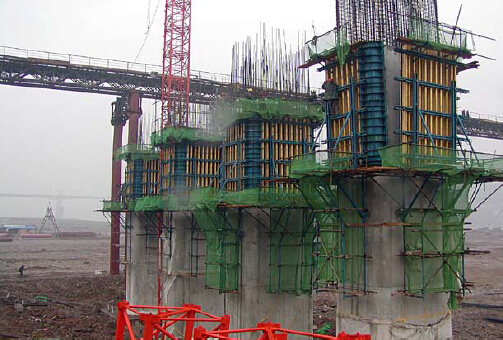
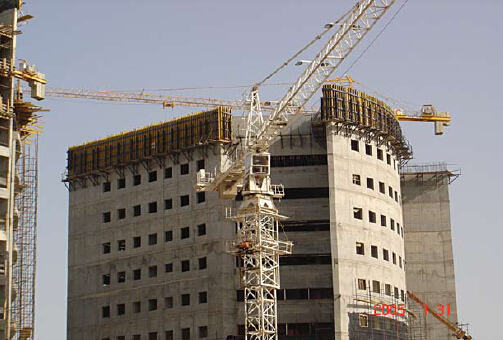
- Q: How does steel formwork perform in seismic zones?
- Steel formwork performs well in seismic zones due to its high strength and durability. Steel is known for its excellent load-bearing capacity and resistance to bending and shearing forces, making it suitable for withstanding the intense shaking and vibrations caused by earthquakes. In seismic zones, the ground experiences significant movement during an earthquake, which can put immense pressure on the formwork system. Steel formwork, being rigid and robust, is able to withstand these forces without any significant deformation or damage. This ensures the stability and integrity of the structure during and after the seismic event. Additionally, steel formwork offers flexibility in design and construction, allowing for the creation of reinforced concrete structures that are better equipped to handle seismic loads. The use of steel formwork enables the incorporation of additional reinforcement elements, such as steel bars and mesh, which enhance the overall strength and ductility of the structure. This helps in dissipating the energy generated by seismic forces and reducing the risk of structural failure. Moreover, steel formwork is reusable and can be easily dismantled and reassembled, making it a cost-effective and sustainable choice for construction in seismic zones. This flexibility allows for the quick repair and reconstruction of structures in the event of earthquake damage, minimizing downtime and ensuring the safety of occupants. Overall, steel formwork is a reliable and resilient choice for construction in seismic zones. Its strength, durability, and flexibility make it well-suited to withstand the forces generated by earthquakes, ensuring the safety and stability of structures in these high-risk areas.
- Q: Can steel formwork be used for office building construction projects?
- Yes, steel formwork can be used for office building construction projects. Steel formwork offers several advantages such as high strength, durability, and reusability, making it suitable for constructing office buildings with complex designs and multiple levels. It allows for fast and efficient construction, ensuring a smooth workflow and meeting project deadlines. Additionally, steel formwork provides a stable and sturdy framework for concrete pouring, ensuring structural integrity and high-quality finishes for office buildings.
- Q: Can steel formwork be easily disassembled and removed after construction?
- Yes, steel formwork can be easily disassembled and removed after construction. Steel formwork systems are designed to be reusable and have a high level of flexibility in terms of assembly and disassembly. The components of steel formwork are typically lightweight and can be easily handled and moved by construction workers. Additionally, steel formwork systems often utilize adjustable clamps and brackets, allowing for quick and efficient disassembly. The ease of disassembly and removal of steel formwork not only saves time and labor costs but also allows for the formwork to be reused in future construction projects, making it a sustainable and cost-effective choice for construction projects.
- Q: How does steel formwork impact the overall project management?
- Steel formwork can have a significant impact on the overall project management. Firstly, steel formwork is known for its durability, strength, and reusability, which allows for multiple uses on different projects. This reduces the need for frequent replacements or repairs, saving both time and money. Additionally, steel formwork offers greater accuracy and precision in construction, resulting in a higher quality end product. It also enables faster construction due to its ease of assembly and disassembly. Moreover, steel formwork provides a safer working environment for laborers, as it is sturdier and more resistant to deformation. Overall, steel formwork positively impacts project management by enhancing efficiency, reducing costs, improving construction quality, and ensuring worker safety.
- Q: What are the common safety guidelines when working with steel formwork in confined spaces?
- To ensure the well-being of workers involved in working with steel formwork in confined spaces, it is crucial to adhere to specific safety guidelines. Consider the following commonly recommended safety measures: 1. Thoroughly assess risks: Prior to commencing work in a confined space, it is imperative to evaluate potential hazards and risks associated with the task at hand. This evaluation should encompass the identification of dangers such as inadequate ventilation, limited access, or the presence of hazardous gases. 2. Ensure sufficient ventilation: Confined spaces often lack proper air circulation, which can result in the accumulation of toxic gases or oxygen deficiency. Before entering, verify that the area is adequately ventilated, and continuously monitor air quality throughout the task. 3. Utilize suitable personal protective equipment (PPE): Workers must always wear the appropriate PPE, which includes safety helmets, goggles, gloves, and respiratory protection as required. The specific PPE necessities may vary depending on the nature of the confined space and associated hazards. 4. Implement adequate lighting: Insufficient lighting in confined spaces can hinder visibility and compromise safety. To mitigate accidents, provide sufficient lighting to ensure clear visibility. 5. Establish proper entry and exit procedures: Clearly define entry and exit procedures for workers entering and exiting confined spaces. This should involve the use of appropriate signage, secure barriers, and the assignment of a responsible individual to monitor and control access. 6. Ensure effective communication: Establish a reliable communication system between workers inside and outside the confined space. This can be achieved through the use of two-way radios, hand signals, or other means of communication to prevent isolation and enable prompt assistance if necessary. 7. Regularly inspect equipment and formwork: Prior to commencing work, inspect the steel formwork and associated equipment for any damage or defects. Promptly address any issues to prevent accidents or structural failures. 8. Provide comprehensive training: Workers involved in working with steel formwork in confined spaces should receive thorough training on safety procedures, hazard recognition, emergency response, and proper equipment usage. Regular training updates should also be conducted to ensure workers remain knowledgeable about safety practices. 9. Establish an emergency response plan: Despite taking necessary precautions, emergencies can still occur. Develop an emergency response plan that outlines evacuation, rescue, and medical assistance procedures. Ensure all workers are familiar with the plan and conduct regular drills to practice these protocols. 10. Regularly review and update safety procedures: Continuously review and update safety procedures to incorporate new regulations, industry best practices, or lessons learned from previous incidents. Continuous improvement and monitoring of safety measures are vital to maintaining a safe working environment. Remember, working in confined spaces with steel formwork carries significant risks. By following these common safety guidelines and fostering a safety-conscious culture, the risk of accidents and injuries can be minimized, ensuring a safer working environment for all.
- Q: How is steel formwork manufactured?
- Steel formwork is manufactured by cutting and shaping steel plates and bars according to the required dimensions and designs. These steel components are then welded together to form the desired formwork panels, beams, and columns. The steel formwork is further reinforced with additional steel bars and mesh, and the surfaces are treated to resist corrosion. Finally, the formwork is assembled and prepared for use in construction projects.
- Q: How does steel formwork handle different concrete curing temperatures?
- Steel formwork is a highly durable and versatile construction material that is well-suited to handle different concrete curing temperatures. The key advantage of steel formwork is its ability to withstand high temperatures without deformation or structural damage. Concrete curing temperatures can vary depending on several factors, such as the climate, project specifications, and construction schedule. Steel formwork is designed to withstand these variations and maintain its structural integrity throughout the curing process. In instances where the concrete curing temperature is high, steel formwork effectively dissipates the heat due to its excellent thermal conductivity. This helps to prevent excessive heat buildup, which could potentially lead to premature curing or thermal cracking of the concrete. The steel formwork acts as a heat sink, absorbing and distributing the heat evenly, ensuring uniform curing throughout the concrete structure. On the other hand, steel formwork also performs well in low-temperature curing conditions. Its high tensile strength and rigidity allow it to withstand the pressure exerted by the cold concrete mix during the curing process. This prevents any distortion or deformation of the formwork, ensuring accurate and precise shaping of the concrete structure. Furthermore, steel formwork is also resistant to moisture and humidity, which are critical factors in curing concrete. It does not absorb water or release moisture, maintaining a consistent moisture content in the concrete during the curing process. This is particularly advantageous in areas with high humidity or where the curing time is extended. Overall, steel formwork is a reliable and robust material that can effectively handle different concrete curing temperatures. Its ability to dissipate heat, withstand cold temperatures, and resist moisture makes it a preferred choice for construction projects where temperature variations are a concern.
- Q: Can steel formwork withstand extreme weather conditions?
- Yes, steel formwork is designed to withstand extreme weather conditions. Steel is known for its strength and durability, making it highly resistant to harsh weather elements such as heavy rain, strong winds, and high temperatures. Additionally, steel formwork is often treated with protective coatings to further enhance its resistance to corrosion and degradation caused by extreme weather conditions.
- Q: What are the different types of bracing used with steel formwork?
- There are several types of bracing commonly used with steel formwork, including diagonal bracing, horizontal bracing, and vertical bracing. Diagonal bracing is used to provide stability and resistance against lateral forces, while horizontal bracing helps to control deflection and ensure the formwork remains in place. Vertical bracing is used to support the formwork system vertically and prevent any potential collapse. These different types of bracing work together to ensure the safety and stability of the steel formwork during construction.
- Q: How does steel formwork handle concrete segregation?
- Steel formwork is a popular choice in construction projects due to its strength and durability. When it comes to handling concrete segregation, steel formwork plays a crucial role in ensuring a homogeneous mixture and preventing the separation of coarse aggregates from the concrete matrix. Concrete segregation occurs when the different components of the concrete mixture, such as cement, water, aggregates, and admixtures, separate due to inadequate mixing or improper handling during placement. This can result in weak spots, reduced strength, and compromised structural integrity. Steel formwork helps prevent concrete segregation in several ways. Firstly, its rigid structure provides a stable and secure framework that holds the concrete in place during pouring and curing. This stability ensures that the concrete mixture remains intact and does not separate. Additionally, steel formwork can be designed with various features that help reduce segregation. For example, the formwork can be equipped with tie rods, clamps, or brackets to hold the form panels tightly together, preventing any movement or displacement of the concrete. These connections minimize the likelihood of aggregate separation and maintain a consistent mixture. Moreover, the smooth surface of steel formwork prevents excessive bleeding and settlement of the concrete, which are common causes of segregation. The lack of surface irregularities or absorbent properties minimizes the escape of water and cement paste, ensuring a more uniform distribution of aggregates within the concrete. Furthermore, steel formwork can be easily cleaned and maintained, preventing the accumulation of hardened concrete or debris that could lead to segregation issues. Regular cleaning and inspection of the formwork help ensure that the concrete is poured into a clean and well-maintained mold, reducing the chances of segregation. In conclusion, steel formwork is an effective solution for handling concrete segregation. Its rigid structure, secure connections, smooth surface, and easy maintenance all contribute to preventing the separation of aggregates from the concrete matrix. By utilizing steel formwork, construction projects can achieve a homogeneous and high-quality concrete placement, resulting in superior structural integrity and durability.
Send your message to us
Single-side climbing bracket for formwork and scaffolding systems
- Loading Port:
- Tianjin
- Payment Terms:
- TT OR LC
- Min Order Qty:
- 50 m²
- Supply Capability:
- 1000 m²/month
OKorder Service Pledge
OKorder Financial Service
Similar products
Hot products
Hot Searches
